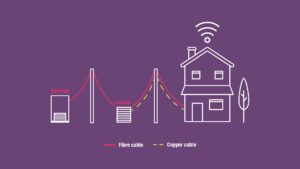Reading Time:
Posted on: November 7, 2022
You may have heard in the news about a Government target to have 85% of premises in the UK to have access to gigabit-broadband.
To achieve this goal, the existing network needs to be corrected and changed. The existing copper networks simply can’t keep up with the increasing demand that the new digital world is requiring.
With working from home now a staple in many businesses, entertainment coming through screens, smartphones, smart watches, smart fridges all requiring a strong connection to keep everyday life ticking over smoothly, a new way of connecting exchanges to premises is needed.
A ‘full fibre’ connection is needed for the Government to meet their target and for everyday life to be significantly improved.
Full fibre describes the connection lines running from your local exchange to your house or place of work; essentially, fibre optic cables are the sole cable used to deliver your broadband.
The current choice of network cables rely on both fibre optic and copper wires. However, these copper wires are becoming outdated and are the cause of most of the slow and inconsistent connection that you may experience.
A lot of companies already claim to use fibre connection, which is true, but they use fibre optic cables partially. This is known as FTTC (Fibre to the Cabinet). The ‘cabinet’ referenced here are the green boxes that you see on your street or you may see a technician attending to.
However, a full fibre connection consists of the aforementioned FTTC as well as FTTP (Fibre to the Premise). The ‘premise’ in this case is your home or your business. Currently, your connection from the cabinet is made from the outdated copper wires. Full fibre connection replaces these with faster, slicker and more efficient fibre optic cables giving you a true full fibre connection.
See below for a visual diagram that can help paint the picture:

There are many benefits of switching to a full fibre connection. More than you may think. Some of these include:
Copper cables were designed to carry voice calls and usually provide around 60 Mbps which simply cannot keep up with our ever-evolving digital world. When switching to a full fibre connection, some have reached speeds of over 1,000mbps (1 gigabit).
Full fibre connections can improve online video calls, enable quicker file transfers and downloads and give you a consistent connection no matter the activity that is happening in your house at any one time.
With around 82% of people in the UK owning a smartphone, the number of devices that rely on a strong connection has increased drastically. With a full fibre connection, your broadband will be able to handle all your devices and more, all without the lag and buffering. Waiting for your devices to catch up with you won’t happen anymore.
With all the emerging content streaming platforms, the rise of YouTube, increased access to online gaming, your connection needs to be able to handle your demand for bandwidth. A full fibre connection can handle all the family’s content needs and more.
If you are interested in receiving a faster connection for your personal or business use, see if we are building in your area. Enter your postcode into our postcode checker and we will let you know if we are coming to you.
If you are wanting to learn more about Fibre Heroes, please browse our website and learn about our products, partners and our current build towns. If you are wanting to know how a full fibre network can benefit you even further, then please get in touch to see how we can help you.